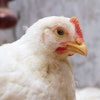
Keeping broiler birds cool using tunnel ventilation depends on proper management of three factors: humidity, temperature and air flow.
Dennis Brothers, a poultry housing extension specialist with Auburn University’s National Poultry Technology Center and Department of Agricultural Economics and Rural Sociology, spoke about how growers can best manage hot conditions on March 14 as part of the 2019 Midwest Poultry Federation Convention in Minneapolis. He established four keys for protecting birds from heat stress and providing an optimum growing environment.

Dennis Brothers, Auburn University | Courtesy of Auburn University/National Poultry Technology Center
1. Use enough fan power
The key to tunnel ventilation – a set up for broiler houses where air is pulled into the house at one end by tunnel ventilation fans at the opposite end – is creating enough air movement to cool the birds.
Brothers said the system only works if a sufficient volume of air is moved to remove heat from the birds. As they eat and grow, birds produce increasing amounts of heat. To cool them, growers must provide a great enough volume of airflow to sufficiently remove the heat and create a wind chill effect.
Simply, the movement of air removes heat generated by the bird’s body. A greater volume of airflow creates a lower effective temperature and the bird feels more cooled. Wind chill effect is not an exact science, however, as it depends on factors like the amount and size of the fans, the capacity and design of the house, and air temperature.
Furthermore, wind chill effect and the ventilation needs of birds depend upon their age and size. Generally, younger birds prefer warmer temperatures because they are smaller with less feather coverage. As they age, their bodies grow, become more feathered and generate more heat. Because of this, younger birds feel wind chill more than older birds.
Brothers set a rough set of rules of thumb for growers to follow, assuming the design is a typical a 40-foot-by-500-foot house using 48-inch diameter fans:
- Young birds feel approximately 2.5 degrees Fahrenheit (1.39 degrees Celsius) temperature wind chill per fan used.
- Four-week old birds feel approximately 1.5 F (0.8 C) wind chill per fan.
- Birds greater than six weeks old feel approximately 1 F (0.5 C) wind chill per fan.
He added the caveats that these numbers change in larger, more populated houses and depend upon the size of the fan used. The wind chill effect will be greater with cold air pulled into the house and lesser with hot air. The wind chill effect is greatly reduced when the exterior temperature is great than 90 F (32.2 C).

The goal of tunnel ventilation is to create enough air flow volume to establish a wind chill effect that cools birds and keeps them more comfortable.
2. Humidity is not your friend
Birds do not cool themselves by perspiration like humans do. Rather, they use internal evaporative cooling through their respiratory tracts – panting – to cool themselves. This form of thermoregulation is less effective as humidity increases. So, even if the temperature reads correctly and feels right to the grower, the birds could be heat stressed due to high humidity.
This means growers need to be careful with how they use their evaporative cooling pads. Although they lower the temperature inside the house, they can increase humidity and actually make it tougher on the birds. Below 80 F (26.7 C), the cooling cells typically should not be used but rather a high volume of airflow should be maintained.
3. Take advantage of nighttime ventilation
Farmers should take advantage of the cooler temperatures by running fans overnight. Generally, temperatures drop overnight but relative humidity increases. They should not use evaporative cooling pads though, as this will create too much humidity and place too much stress on the birds.
Brothers said house controllers normally turn the fans off when temperatures decrease, but this can be a mistake for older birds at night. Instead, at least some of the fans should be set to keep running all night to create a minimum ventilation level. This gives the birds a chance to recover from a hot, humid day.
4. Never let the cool cell turn a fan off
Brothers said evaporative cooling pads are a useful tool. But, they are compliments to tunnel ventilation not a replacement for tunnel ventilation.
Again, cooling pads can lower the inside air temperature but they can cause stress on the birds by raising humidity and restricting their ability to cool themselves. The temperature drop they produce however can also result in house controllers turning fans off, restricting overall ventilation air flow.
Therefore, it’s a serious error to manage the cool cells in such a way that turns off a fan. By dropping the volume of airflow and increasing humidity, growers can put significant stress on their birds. A simple rule of thumb to avoid this mistake is: If the cooling pads coming on quickly causes a fan to turn off or a vent level to decrease, then raise the cooling pads’ on temperature by 2 F (1.1 C).


















